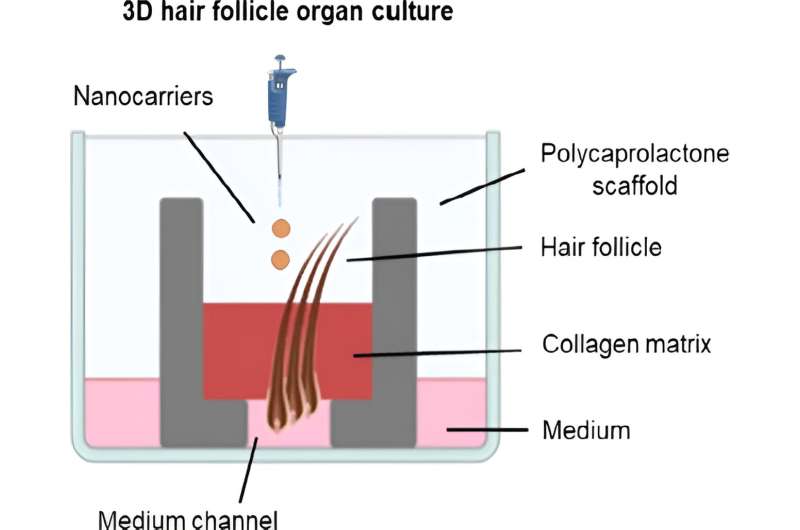This article has been reviewed according to Science X's editorial process and policies. Editors have highlighted the following attributes while ensuring the content's credibility:
fact-checked
trusted source
proofread
Researchers develop 3D printed model for targeted antibiotic therapy against follicular infections

Hair follicle infections are often difficult to treat because bacteria settle in the gap between hair and skin, where it is difficult for active substances to reach them.
In order to investigate this scenario more closely in the laboratory, researchers from the Department of Drug Delivery Across Biological Barriers at the Helmholtz Institute for Pharmaceutical Research Saarland (HIPS) have now developed a model with human hair follicles embedded in a matrix produced using 3D printing.
In the future, this model can be used to test the effectiveness of new drug candidates against corresponding pathogens directly on human follicles. The team has published their results in the journal ACS Biomaterials Science & Engineering.
Hair follicles are complex structures that surround the hair root, anchoring it to the skin and giving the hair its hold. At the same time, the area between the skin and the follicle provides optimal conditions for microorganisms to multiply unhindered.
This often leads to chronic inflammation of the follicle, which is not only painful, but in the case of acne inversa can also trigger secondary diseases such as diabetes mellitus or even acute sepsis. In Germany alone, approximately 830,000 people are currently affected by this disease.
In order to successfully develop new active substances against hair follicle inflammation, models are required that can simulate the physiological conditions of the skin in the laboratory as realistically as possible.
A team led by Prof. Claus-Michael Lehr at HIPS, a site of the Helmholtz Center for Infection Research (HZI) in collaboration with Saarland University, has now developed such a model. By transplanting living human hair follicles into a collagen matrix within a 3D-printed polymer scaffold, the researchers were able to successfully replicate the natural environment of hair follicles.
"The model has the advantage that we can test new drug candidates in the hair follicle microenvironment at an early stage of development without having to resort to animal testing," says Samy Aliyazdi, first author of the study.
Previously, new drug candidates for hair follicle infections were initially tested in simpler models, such as free-floating human hair follicles in liquid culture. However, these models do not adequately represent the actual conditions in patients and are therefore not ideal for biological efficacy studies.
Using the new 3D model, researchers have already shown that nanoparticles penetrate and distribute better in hair follicles than in free-floating hair follicle cultures.
Nanoparticles are therefore able to penetrate deep into the hair follicles and are suitable as carriers for active ingredients. Lehr's team was also able to show that hair follicle infections with the hospital pathogen Staphylococcus aureus can be fought significantly better if the antibiotic rifampicin is "packaged" in such nanoparticles.
The described 3D model of human hair follicles overcomes some of the challenges associated with previous laboratory models.
"Our model provides a more realistic replication of the human hair follicle microenvironment and can be cultured over the long term. But we have not yet reached the end of the road. We need to further optimize the mechanical properties of the polymer. We are also planning to include additional cell types, such as fibroblasts and immune cells, to make the model even more representative of the patient's situation," says Aliyazdi.
A more complex model of this type has great potential to provide valuable early insights into hair follicle viability, pathogen behavior, and ultimately the predictability of drug efficacy and safety assessments.
Lehr emphasizes, "Our research shows that mimicking the natural hair follicle environment is critical to assessing the efficacy of antibiotics. This model could significantly accelerate the development of new, targeted therapies while reducing the number of animal studies required."
More information: Samy Aliyazdi et al, A Novel 3D Printed Model of Infected Human Hair Follicles to Demonstrate Targeted Delivery of Nanoantibiotics, ACS Biomaterials Science & Engineering (2024). DOI: 10.1021/acsbiomaterials.4c00570
Provided by Helmholtz Association of German Research Centres





















